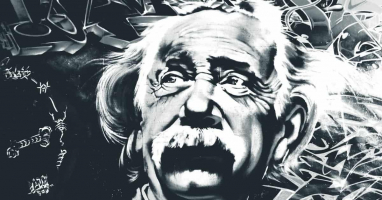I wrote this article in Japanese and translated it into English using ChatGPT. I also used ChatGPT to create the English article title. I did my best to correct any translation mistakes, but please let me know if you find any errors. By the way, I did not use ChatGPT when writing the Japanese article. The entire article was written from scratch by me, Saikawa Goto.
Introduction
Movies and books covered in this article

Three takeaways from this article
- “Entanglement” was a phenomenon that was hard to understand based on the scientific knowledge of the time.
- Einstein came up with a brilliant thought experiment to criticize quantum mechanics.
- After his death, the debate over whether Einstein’s critique was correct or not was settled.
Self-introduction article


Published Kindle books(Free on Kindle Unlimited)
“The genius Einstein: An easy-to-understand book about interesting science advances that is not too simple based on his life and discoveries: Theory of Relativity, Cosmology and Quantum Theory”
“Why is “lack of imagination” called “communication skills”?: Japanese-specific”negative” communication”
The quotes in the article were translated using ChatGPT from Japanese books, and are not direct quotes from the foreign language original books, even if they exist.
Structure of This Book and This Article
This book is a detailed work that describes the discussions and discoveries of scientists, centered around a phenomenon called “entanglement.” In addition, by picking up letter exchanges from various sources, it is a work that puts enormous effort into reproducing “delusional conversations” such as “scientists must have had such exchanges in the past.” Regarding the “reproduction of conversations among past scientists,” which is not common in ordinary non-fiction books, I strongly recommend experiencing it in this book.

In this article, I will compress the explanation of “entanglement” and its history of discovery, described in this book, into a compact form.
How was the Strange Phenomenon of “Entanglement” in Quantum Mechanics Discovered and Utilized?
Rough Explanation of “Entanglement”

First, let me explain briefly what “entanglement” is.
For example, let’s say there are two atoms and they are 10 billion km apart. If these two atoms are in an “entangled” state, any operation performed on one atom will instantaneously affect the other atom.
In other words, it means that even though they are 10 billion km apart, these two atoms behave as if they were one object. And this state is called “entanglement.”
It may feel like you don’t understand the meaning, but that’s okay.

The reason is that although the existence of a state called “entanglement” is recognized, anyone still do not understand why it happens. Even as scientists, they are in a state of “we have to accept entanglement because that’s what happens when we do experiments, but we don’t really understand it.”
However, this enigmatic phenomenon called “entanglement” may be used to greatly change our human lives. That’s where the “quantum computer” comes in. Compared to current supercomputers, quantum computers, which are said to have computing speeds that are incomparable, are based on the basic principle of the state of “entanglement”. So in that sense, it’s not something completely unrelated to us.

This mysterious phenomenon started to be widely discussed after Einstein created a thought experiment to criticize Bohr, who is known as a central figure in quantum mechanics. Let’s first explain the development of the field of “quantum mechanics” in order.
What is “Quantum Mechanics” in the First Place?
First, let’s take a rough overview of how the field of “quantum mechanics” developed.
At the end of the 1800s, there was a dominant feeling in the scientific world that “everything had already been explained.” However, Einstein created the “Theory of relativity,” and furthermore various scientists gathered to develop “quantum mechanics.” Then, these two theories were a driving force the world of science after the beggining of the 1900s.


The birth of “quantum mechanics” was triggered by the discovery of “phenomena that cannot be explained by previous scientific theories.” Scientists tried to explain in various ways but nothing worked out. Then, a scientist named Planck came up with the “desperate” idea that “the energy of light takes discontinuous values.”
What does that mean?

Until then, it was thought that energy could take on any value. However, Planck came up with the idea that energy can only take on values that are integer multiples of a constant he called the “Planck constant.”
Here’s an example: let’s say all the apples in the world weigh the same (100g). When you weigh an apple on a scale, the display should increase by 100g, 200g, 300g, and so on. It should never display something like 284g when you put an apple on it. The display will always show a multiple of 100g.
Similarly, Planck thought that the energy of light can only take on values that are integer multiples of the Planck constant.

It seems that Planck came up with this assumption on a whim, as he couldn’t think of any other way. But amazingly, it worked. The phenomena that couldn’t be explained by previous science were explained by Planck’s theory.
This is how “quantum mechanics” was born.
Planck’s explanation certainly described the phenomena well, but on the other hand, it was completely unclear what it meant.

The discussion of “particles” and “waves” comes up here. At this time, “light” was thought to be a “wave”.
The term “takes discontinuous values” is “discontinuous quantity” and corresponds to “particle”, while “takes any value” is “continuous quantity” and corresponds to “wave”.
While “light” has been explained as a “wave” so far, now Planck has used properties of “particles” to explain mysterious phenomena. Is “light” both a “wave” and a “particle”? What does this mean?

The duality of “waves” and “particles” has been found to be present in various situations, not just in light. In fact, Einstein’s Nobel Prize was not awarded for his famous “Theory of relativity”, but for his contribution in showing that “if we consider light, which was thought to be a wave, as a particle, we can easily explain a certain phenomenon.”
Thus, the feature of “quantum mechanics” is that in the extremely small realm of atoms, etc., there exists a state where things are both waves and particles, and to this day, no scientist can fully grasp the nature of this “wave-particle duality”.


Quantum mechanics is a genre in which a lot of mysterious claims exist.
If you don’t get dizzy when you think about quantum mechanics, then you haven’t really understood it.
This words by Bohr, mentioned above, are also very famous.

Problem Pointed Out by Einstein
Einstein is known for opposing quantum mechanics until his death. His famous statement “God doesn’t play dice” means roughly “I don’t accept quantum mechanics.”
Let’s take a look at what kind of criticism Einstein made.

In quantum mechanics, there is an equation called the “Schrödinger equation” that scientists consider to be correct and describe reality well. However, they have been unsure about what the “wave function,” the answer obtained by solving the “Schrödinger equation,” represents in reality. It means “we don’t know what the wave function corresponds to in reality.”
Eventually, a concept called the “probabilistic interpretation” emerged, which suggests that the “wave function (squared)” represents the probability of where a particle exists.
Let’s explain how absurd this idea is.

For example, the sentence “A was at the station at 12 o’clock” seems normal. It is normal to claim that “a person (or an object) was present at a certain place at a certain time”. And if that is the case, the same should be said for particles. In other words, it means that we can observe that “a particle was present at a certain place at a certain time”. It’s natural, isn’t it?
Moreover, in science so far, we have been able to calculate how an object moves using various equations. This means that if we know information such as the initial state and velocity, we can predict “the position of the object at a certain time” by solving the equation.

However, in the case of quantum mechanics, things are different. Even if you solve the equation, you can only know the “probability of a particle existing in a certain place at a certain time.” This means that even if you observe it and see that it’s “here,” the equation of quantum mechanics only tells you that “it might be here.”
You might feel like there’s something wrong with that. That doubt is reasonable. In fact, Einstein criticized it, saying “That’s ridiculous.” The phrase “God doesn’t play dice” succinctly expresses his belief that “anything that can only be understood in terms of probability is incomplete as a science, and if we understand it correctly, we should be able to know something exact instead of just probabilities.”


However, at that time, the scientists did not take Einstein’s comments seriously. There were several reasons for this.
The biggest reason was that they were “too busy studying the newly-born field of quantum mechanics.” When this new field of study suddenly emerged, there were a lot of problems to solve.
Einstein’s indicates can be summarized as “the interpretation of the wave function is wrong,” but to be honest, the “interpretation of the wave function” was not important to the scientists at that time. No matter how they interpreted the wave function, it would not change the calculation results. Einstein’s comments were dismissed with the words, “We’re busy with practical problems, so we don’t care about philosophical indicates like that.”

I’ve read a book that guesses Bohr, who is known for leading quantum mechanics, acted like “I’ll deal with Einstein, you young guys focus on your research.” Bohr liked to mentor young scientists while Einstein preferred to work alone. Because of Bohr’s strong influence in quantum mechanics, Einstein’s ideas were relatively ignored.
Einstein realized that his questions were very important in quantum mechanics (and he was right). But he realized that it was difficult to get other scientists to pay attention to him as it was. So, he co-wrote a famous paper called “the EPR paper” with two other scientists, Podolsky and Rosen.

And the EPR paper played a crucial role in directing scientists’ attention to a phenomenon called “entanglement”.
What Role did the EPR Paper Play?
Einstein had been trying to prove that quantum mechanics was incomplete, but all of his arguments before the EPR paper had been refuted by Bohr. Therefore, Einstein decided to change his approach with the EPR paper.
Before the paper, the theoretical state of “entanglement” was already known, but its strangeness was not fully understood. Einstein argued that “entanglement is such a strange phenomenon that quantum mechanics, which allows for such a state to exist, is incomplete.” In other words, Einstein’s position was that “the phenomenon of entanglement is impossible.”

Einstein’s claim was ultimately proven incorrect, and it was not until after both he and Bohr had passed away that it was discovered that the state known as “entanglement” actually exists (due to technical constraints, conducting experiments on entanglement was impossible during their lifetime). However, Einstein’s publication of “the EPR paper” did deepen our understanding of entanglement, and it came to be recognized as a very important point in quantum mechanics. In that sense, Einstein played a very significant role in the development of quantum mechanics.
This book is written as follows:
To talk about entanglement is to talk about quantum physics itself. Physicists first encountered the problem of entanglement in the 20th century. For centuries, physics had been advancing relentlessly in an attempt to completely understand the world. But in the early 20th century, the story of entanglement began when they doubted the oddity of quantum theory. The dawn of the 20th century brought us news. It is that the more we explore both matter and light, the more mysteries arise.

What Kind of Argument is Made in the EPR Paper?
Now, I would like to explain Einstein’s thought experiment presented in the EPR paper in an easy-to-understand way.

Suppose there are two scratch lottery tickets, A and B. These two tickets are related in such a way that “if one is a winner, the other is a loser.” In other words, it is either “A: winner, B: loser” or “A: loser, B: winner.” And let’s use the term “observe” to refer to the act of scratching off the silver part of the scratch lottery.

Now, if you think about it in a very ordinary way, this scratch lottery should have already determined whether it’s a winner or a loser before you “observe” it. This is Einstein’s idea.
On the other hand, Bohr didn’t think that way. Bohr argues that the result of scratch lottery A and B is not determined until the moment of “observation” (this Bohr school of thought is called the “Copenhagen interpretation”). You may think it’s ridiculous, but for now, please understand that “Bohr claimed so”. Basically, Bohr is saying that “when you ‘observe’ A and determine whether it’s a winner or a loser, that information is somehow transmitted to B, and B is then determined to be a loser or a winner”. Let’s just go with that for now.

Well, in the EPR paper, Einstein wanted to show that “your argument leads to some strange consequences. So your idea is wrong, and thus, we can say that quantum mechanics is incomplete.”
So how did Einstein proceed with the discussion?
Now, let’s imagine two scratch lotteries, A and B, which are separated by 10 billion kilometers. Let’s say we “observe” A, and then immediately after, we “observe” B (this is impossible in reality, but let’s think of it as a thought experiment).
According to Einstein’s idea, there would be no problem with this. However, according to Bohr’s idea, something strange will happen. Bohr’s logic should not be valid if the scratch lotteries were 10 billion kilometers apart.

I repeat, Bohr claimed that the outcome is undetermined until “observed”. In other words, it is confirmed that B is a “losing,” the moment that A is “observed” and it turns out that A is a “winning”.
However, how does the information “A is a winning” get to B? If “the outcome is undetermined until observed,” then “the fact that the outcome has been determined must be communicated to the other side.” But there is a problem here.
This is because it takes 9.2 hours even at the speed of light to travel 10 billion kilometers (I derived this number through calculation, but please point it out if it is incorrect). According to Einstein’s “Theory of Relativity,” it is understood that “nothing can move faster than light (principle of invariant light speed),” so it is impossible to move faster than 9.2 hours.

According to Bohr’s idea, communication between A and B is essential, but if they are 10 billion km apart, the communication will take at least 9.2 hours even at the fastest speed. However, even if they observe A and then immediately observe B, the result should definitely be “losing”. This is clearly contradictory.
In this way, Einstein pointed out that “if we allow for the phenomenon of entanglement, scientifically unreasonable phenomena can occur.”
This is known as the ERP paradox, which is Einstein’s thought experiment (it’s my own explanation).

Bohr’s Reaction and the Subsequent Surprising Developments
In response to Einstein’s criticism, Bohr apparently made some counterarguments. Although his rebuttal was not very clear, the scientists of the time seemed to have been convinced, thinking that since Bohr had been winning arguments with Einstein all along, his counterargument of this time must be also correct.


In fact, the EPR paper, which is now recognized as an important assertion, did not receive much attention during Einstein’s lifetime. Therefore, without much discussion of the details, it ended with the impression that “Bohr had won.”
The reason why attention was again drawn to the EPR paper was due to two scientists, Bohm and Bell.
To put it briefly, what Bohm did was to “create a hidden variable theory.” In other words, he showed Einstein’s assertion more concretely. Einstein argued that “quantum mechanics is incomplete and there must be another theory that is not incomplete,” but Bohm presented a theory that said, “if there is a theory that is not incomplete as Einstein says, it would probably be something like this.”

“Hidden variable theory” is a type of theory that suggests there are elements that humans have not yet realized exist. If we were aware of these elements, we would understand seemingly inexplicable phenomena as perfectly normal.
Let me explain this with a concrete example. Suppose humans have not realized the existence of “temperature.” In this case, the phenomenon of “melting ice with the palm of your hand” would seem mysterious. However, if we become aware of the element “temperature,” this phenomenon would no longer be a mystery.
Bohm created a theory that suggests that if we assume such undiscovered elements exist, quantum mechanics would no longer be mysterious.

And one who was inspired by Bohm’s “hidden variable theory” was Bell. He was one of the people who believed in it and was encouraged by reading Bohm’s paper.
However, at that time, a brilliant mathematician named John von Neumann had published a paper stating that “hidden variable theory is impossible in quantum mechanics.” He was highly trusted, and it was widely believed that “if Neumann says hidden variable theory is impossible, then it must be.” (In fact, it was later discovered that Neumann’s proof had flaws and was incorrect.) In such an environment, it took courage to express support for the hidden variable theory.
Inspired by Bohm, Bell considered the “hidden variable theory” and later derived a very famous equation called “Bell’s inequality.” This is an inequality that shows “under what conditions can hidden variable theory be considered correct.” If this inequality holds true, then Einstein, Bohm, and Bell’s theory will be considered correct.

The impact of “Bell’s inequality” was so great that it was written about as follows:
There is no doubt that Bell’s paper brought about a revolution in physics by the beginning of the 21st century.
In addition, by citing Einstein’s “the EPR paper” in the paper, attention was once again drawn to it. Einstein’s theories and proposals often attract renewed attention after his death.


Furthermore, the EPR paper did more than just make an impact.
Among all of Einstein’s outstanding achievements, the EPR paper stands out as the most frequently cited paper, and it became the most cited paper in the major physics journal of the latter half of the 20th century, “Physical Review”.
Out of all of Einstein’s famous papers, the EPR paper was the most cited.
Now, during the time that Bohr and Einstein were alive, it was impossible to perform the experiment proposed in the EPR paper. However, with technological advancements and a shift in thinking, it became possible. Finally, an experiment was conducted to determine whether “Bell’s inequality” holds true or not.

What were the results?
Surprisingly, it was revealed that “Bell’s inequality” did not hold true. This means that Einstein was wrong. Einstein argued that quantum mechanics, which postulates strange phenomena such as entanglement, was incorrect. However, this assertion has been proven to be incorrect. In other words, the state of “entanglement” actually exists, and the “hidden variable theory” does not hold up.
However, this experiment does not prove that the Copenhagen interpretation is correct. It simply means that Einstein’s interpretation is incorrect. There are various interpretations of quantum mechanics besides “Einstein’s interpretation” and “Bohr’s interpretation.” Just because “Einstein’s interpretation” has been disproven does not mean that “Bohr’s interpretation” is correct.
In any case, thanks to Einstein’s contribution, the importance of “entanglement” has been recognized, and it is now being used practically as a basis for quantum computers.

Conclusion
The things mentioned in this article are only a small part of this book. When it comes to quantum mechanics, there are plenty of interesting and strange stories, and the interest never ends. Unlike “Theory of Relativity,” which Einstein created all by himself, “quantum mechanics” progressed through heated discussions among contemporary genius scientists. That’s why it’s so dramatic.


Published Kindle books(Free on Kindle Unlimited)
“The genius Einstein: An easy-to-understand book about interesting science advances that is not too simple based on his life and discoveries: Theory of Relativity, Cosmology and Quantum Theory”
“Why is “lack of imagination” called “communication skills”?: Japanese-specific”negative” communication”







コメント